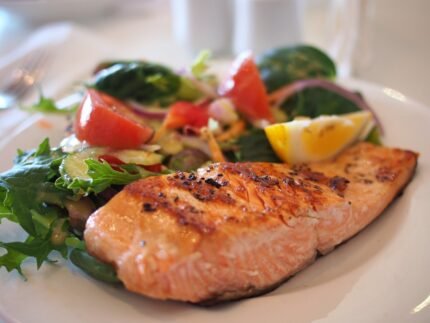Medically reviewed by Dr. Ramesh Gaddam, M.D. — Written by Sumalatha, D.N.H.E
Building lean muscle isn’t just about hitting the weights hard; it’s also about giving your body the right fuel to repair and grow stronger.
A balanced diet rich in protein, healthy fats, and essential nutrients is crucial for anyone looking to pack on muscle mass while staying lean.
Here are some top muscle-building foods to incorporate into your diet:
1. Chicken Breast
Chicken breast is a nutritional powerhouse that has earned its place as a staple in the diets of fitness enthusiasts worldwide. Here’s why:

High Protein Content:
One of the main reasons chicken breast is favored by those looking to build lean muscle is its high protein content.
Protein is essential for muscle repair and growth, making it a crucial component of any muscle-building diet.
A 3-ounce serving of chicken breast packs approximately 27 grams of protein, providing your muscles with the building blocks they need to recover and grow stronger after a workout.
Low in Fat:
Unlike other cuts of meat that may be higher in fat, chicken breast is incredibly lean.
It contains minimal amounts of saturated fat, making it an ideal choice for those who want to build muscle while keeping their fat intake in check.
By choosing grilled or baked chicken breast over fried or breaded varieties, you can further minimize the fat content and maximize its muscle-building potential.
Nutrient Density:
In addition to its protein content, chicken breast is also a good source of essential nutrients such as vitamin B6, niacin, phosphorus, and selenium.
These nutrients play various roles in supporting overall health and optimal muscle function.
For example, vitamin B6 is involved in protein metabolism, while selenium acts as an antioxidant, protecting cells from damage caused by free radicals.
Versatility:
Chicken breast is incredibly versatile and can be prepared in countless ways to suit different tastes and preferences.
Whether you prefer to grill, bake, sauté, or slow-cook it, there are endless possibilities for incorporating chicken breast into your meals.
You can marinate it in herbs and spices, pair it with vegetables, or add it to salads, soups, stir-fries, and wraps for a nutritious and satisfying meal.
Tips for Cooking Chicken Breast
Grilling or Baking:
Grilling or baking chicken breast is preferred over frying, as it helps retain its natural flavor and juiciness while keeping the fat content low.
Season the chicken with your favorite herbs, spices, and a touch of olive oil for added flavor.
Avoiding Overcooking:
Be cautious not to overcook chicken breast, as it can become dry and tough.
Use a meat thermometer to ensure it reaches an internal temperature of 165°F (75°C) without overdoing it.
Meal Prep:
Chicken breast is an excellent option for meal prep, as you can cook a batch of it at once and portion it out for easy grab-and-go meals throughout the week.
Store cooked chicken breast in the refrigerator for up to four days or freeze it for longer-term storage.
Incorporating chicken breast into your diet is a delicious and convenient way to fuel your muscles and support your fitness goals.
With its high protein content, low fat, and versatility, it’s no wonder why chicken breast remains a go-to choice for building lean muscle.
2. Salmon
Salmon is often touted as one of the healthiest foods you can eat, and for good reason.
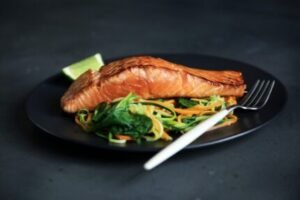
Not only is it a fantastic source of protein, but it’s also packed with omega-3 fatty acids, making it a powerhouse for muscle recovery and overall health.
Omega-3 Fatty Acids:
Omega-3 fatty acids, particularly EPA (eicosapentaenoic acid) and DHA (docosahexaenoic acid), are essential fats that play a crucial role in various bodily functions, including muscle repair and growth.
These fatty acids are known for their anti-inflammatory properties, which can help reduce muscle soreness and inflammation after intense workouts.
By incorporating omega-3s into your diet through foods like salmon, you can support faster recovery times and optimize muscle recovery.
High-Quality Protein:
Salmon is an excellent source of high-quality protein, providing all the essential amino acids your body needs to build and repair muscle tissue.
A 3-ounce serving of salmon contains around 22 grams of protein, making it a satisfying and muscle-building addition to any meal.
Protein is essential for repairing and rebuilding muscle fibers that are broken down during exercise, making salmon an ideal post-workout option.
Nutrient Density:
In addition to omega-3 fatty acids and protein, salmon is also packed with various vitamins and minerals that are beneficial for overall health and muscle function.
It’s a rich source of B vitamins, including B12 and niacin, which play key roles in energy production and muscle metabolism.
Salmon also provides important minerals like potassium and selenium, which are essential for maintaining proper muscle function and supporting overall health.
Wild-Caught vs. Farm-Raised:
When choosing salmon, opt for wild-caught varieties whenever possible.
Wild-caught salmon tends to be higher in omega-3 fatty acids and lower in pollutants compared to farm-raised salmon.
Wild-caught salmon also typically has a richer flavor and firmer texture, making it a preferred choice for many seafood enthusiasts.
Look for labels indicating that the salmon is sustainably sourced to ensure you’re making an environmentally conscious choice.
Cooking Tips:
Grilling or Baking:
Grilling or baking salmon is a simple and delicious way to prepare it while preserving its natural flavor and nutrients.
Season the salmon with herbs, spices, and a squeeze of lemon for added zest.
Salmon Salad:
Flake cooked salmon over a bed of mixed greens for a refreshing and protein-packed salad.
Add your favorite vegetables, nuts, and a drizzle of olive oil for a nutritious and satisfying meal.
Salmon Tacos:
Use grilled or baked salmon as a filling for tacos, along with avocado, salsa, and a dollop of Greek yogurt for a healthy twist on a classic dish.
Incorporating salmon into your diet on a regular basis is a smart choice for anyone looking to support muscle recovery, boost overall health, and enjoy delicious meals.
With its abundance of omega-3 fatty acids, high-quality protein, and nutrient density, salmon is truly a superfood for building and maintaining lean muscle.
3. Greek Yogurt
Greek yogurt has become a favorite among health-conscious individuals, and for good reason.

Not only is it a rich source of protein, but it also contains beneficial probiotics that support digestion and gut health, making it an excellent choice for anyone looking to build lean muscle and maintain overall wellness.
Protein Content:
One of the standout features of Greek yogurt is its impressive protein content.
Compared to regular yogurt, Greek yogurt is strained to remove much of the whey, resulting in a thicker, creamier texture and a higher concentration of protein.
A single serving of Greek yogurt can contain anywhere from 15 to 20 grams of protein, depending on the brand and variety.
This protein is essential for muscle repair and growth, making Greek yogurt an ideal option for post-workout recovery.
Probiotics for Digestive Health:
In addition to its protein content, Greek yogurt also contains probiotics, which are live microorganisms that provide numerous health benefits, particularly for digestive health.
These beneficial bacteria help maintain a healthy balance of gut flora, which is crucial for proper digestion and nutrient absorption.
By supporting a healthy gut, probiotics may also indirectly support muscle recovery and overall wellness.
Choosing the Right Variety:
When selecting Greek yogurt, it’s important to opt for plain, unsweetened varieties to avoid added sugars and unnecessary calories.
Many flavored yogurts contain high amounts of added sugars, which can counteract the health benefits of the yogurt.
Instead, choose plain Greek yogurt and sweeten it naturally with fresh fruit, honey, or a sprinkle of cinnamon for added flavor without the excess sugar.
Versatility in Usage:
Greek yogurt is incredibly versatile and can be enjoyed in various ways as part of a muscle-building diet.
Here are a few ideas:
Snack:
Enjoy Greek yogurt on its own as a satisfying and protein-rich snack between meals.
Add a handful of nuts or seeds for extra crunch and nutrients.
Post-Workout Meal:
After a workout, mix Greek yogurt with fruit, such as berries or bananas, for a quick and replenishing post-workout snack.
The combination of protein and carbohydrates will help support muscle recovery and replenish glycogen stores.
Smoothies:
Incorporate Greek yogurt into smoothies for a creamy texture and an extra protein boost.
Blend it with your favorite fruits, vegetables, and a scoop of protein powder for a nutritious and filling meal or snack.
Salads and Dressings:
Use Greek yogurt as a base for creamy salad dressings or dips.
Mix it with herbs, garlic, and lemon juice for a flavorful dressing that’s perfect for drizzling over salads or dipping vegetables.
Summary:
Greek yogurt is a nutritional powerhouse that provides a potent combination of protein and probiotics, making it an excellent addition to any muscle-building diet.
By choosing plain, unsweetened varieties and incorporating it into your meals and snacks, you can support muscle recovery, promote digestive health, and enjoy delicious and nutritious foods that fuel your gains.
4. Eggs
Eggs have long been hailed as a nutritional powerhouse, and for good reason.

They’re not only a rich source of high-quality protein but also packed with essential vitamins and minerals that support muscle function and overall health.
Here’s why you shouldn’t skip this superfood, especially if you’re aiming to build lean muscle:
High-Quality Protein:
Eggs are an excellent source of complete protein, containing all nine essential amino acids that your body needs for muscle repair and growth.
With around 6 grams of protein per large egg, they provide a substantial amount of this crucial nutrient to help support your muscles after a workout.
Vitamins and Minerals:
In addition to protein, eggs are loaded with vitamins and minerals that are essential for optimal health and muscle function.
They’re particularly rich in:
Vitamin D:
Eggs are one of the few natural food sources of vitamin D, a nutrient that plays a crucial role in bone health, immune function, and muscle strength.
Adequate vitamin D levels are essential for maintaining optimal muscle function and supporting overall athletic performance.
Choline:
Egg yolks are a significant source of choline, a nutrient that is important for brain health, nervous system function, and muscle control.
Choline also plays a role in metabolism and muscle recovery, making it an essential nutrient for athletes and fitness enthusiasts.
Vitamin B12:
Eggs are a good source of vitamin B12, which is necessary for energy production, red blood cell formation, and neurological function.
Adequate vitamin B12 levels are important for maintaining stamina and preventing fatigue during workouts.
B Vitamins:
Eggs contain various B vitamins, including riboflavin (B2), pantothenic acid (B5), and folate (B9), which are involved in energy metabolism and the production of red blood cells.
These vitamins help convert food into energy and support muscle function.
Importance of Egg Yolks:
It’s essential not to skip the egg yolks, as they contain many of the essential nutrients found in eggs, including vitamin D, choline, and various antioxidants.
While egg whites are primarily protein, the yolks provide valuable nutrients that support overall health and muscle function.
Including the yolks also adds flavor and richness to dishes, making eggs a more satisfying and enjoyable food choice.I
Incorporating Eggs into Your Diet:
There are countless ways to enjoy eggs as part of a muscle-building diet:
Breakfast:
Start your day with a protein-rich breakfast by enjoying eggs in various forms, such as scrambled, poached, or in an omelet with vegetables.
Snacks:
Hard-boiled eggs make a convenient and portable snack that provides a quick protein boost between meals.
Post-Workout Meal:
After a workout, refuel your muscles with a hearty meal containing eggs, such as a vegetable and egg scramble or an egg salad sandwich.
In Recipes:
Use eggs as a versatile ingredient in recipes, such as baking, making homemade protein bars, or adding them to stir-fries and salads for an extra protein punch.
Summary:
Eggs are a nutritional powerhouse that provides high-quality protein, essential vitamins, and minerals necessary for muscle building and overall health.
By including eggs in your diet and enjoying them with the yolks intact, you can support muscle function, boost energy levels, and optimize your performance in the gym.
Don’t overlook this versatile and nutritious superfood on your journey to building lean muscle and achieving your fitness goals.
5. Lean Beef
When it comes to building lean muscle, lean cuts of beef, such as sirloin or tenderloin, are an excellent choice.
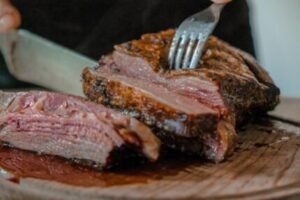
Not only are they rich in high-quality protein, but they also provide essential nutrients like iron and zinc, which are crucial for muscle growth and repair.
Here’s why lean beef should be on your muscle-building menu:
High-Quality Protein:
Beef is a complete protein source, meaning it contains all nine essential amino acids that your body needs for muscle repair and growth.
A 3-ounce serving of lean beef provides around 25 grams of protein, making it an efficient way to meet your daily protein needs.
Protein is essential for repairing and building muscle tissue, making lean beef an ideal option for anyone looking to increase muscle mass.
Iron:
Lean beef is a rich source of heme iron, which is the type of iron that is most easily absorbed by the body.
Iron is necessary for the production of hemoglobin, a protein in red blood cells that carries oxygen to muscles and tissues.
Adequate iron intake is crucial for maintaining energy levels and supporting muscle function, especially during intense workouts.
Including lean beef in your diet can help prevent iron deficiency and optimize muscle performance.
Zinc:
Beef is also an excellent source of zinc, a mineral that plays a key role in protein synthesis, immune function, and hormone regulation.
Zinc is involved in various processes within the body, including muscle repair and growth.
Consuming lean beef can help ensure that you’re meeting your daily zinc requirements, which is essential for maximizing muscle-building potential and overall health.
Mindful Portion Sizes:
While lean beef is a nutritious addition to a muscle-building diet, it’s important to be mindful of portion sizes.
Aim for a serving size of around 3-4 ounces, which is about the size of a deck of cards.
This will provide you with a sufficient amount of protein and nutrients without going overboard on calories or saturated fat.
Choosing Grass-Fed Beef:
Opting for grass-fed beef whenever possible is recommended for several reasons.
Grass-fed beef tends to be leaner and contain higher levels of omega-3 fatty acids and antioxidants compared to conventionally raised beef.
Additionally, grass-fed beef is often raised in more humane and sustainable farming practices, making it a better choice for both your health and the environment.
Cooking Tips:
Grilling or Broiling:
Lean beef cuts like sirloin or tenderloin are best cooked using dry heat methods such as grilling or broiling.
This helps retain their natural flavor and juiciness while minimizing added fats.
Marinating:
Marinating lean beef in a mixture of herbs, spices, and acidic ingredients like vinegar or citrus juice can help tenderize the meat and add flavor without adding extra fat or calories.
Serving Suggestions:
Serve lean beef with a side of roasted vegetables, steamed greens, or a whole grain like quinoa or brown rice for a balanced and satisfying meal that supports muscle growth and recovery.
Incorporating lean beef into your diet is a tasty and nutritious way to fuel your muscle-building efforts.
With its high protein content, iron, and zinc, lean beef provides the essential nutrients your body needs to repair and grow stronger muscles.
Just remember to enjoy it in moderation and choose grass-fed options when possible for maximum health benefits.
6. Quinoa
Quinoa has gained popularity in recent years as a nutritious and versatile grain alternative.

It’s not only a complete protein source, providing all nine essential amino acids necessary for muscle repair and growth, but it’s also packed with fiber and complex carbohydrates, making it an ideal choice for sustained energy and muscle recovery.
Here’s why quinoa deserves a place in your muscle-building diet:
Complete Protein Source:
Quinoa stands out among grains because it’s a complete protein source, containing all nine essential amino acids that your body cannot produce on its own.
This makes it an excellent plant-based protein option for vegetarians and vegans, as well as anyone looking to diversify their protein sources.
With approximately 8 grams of protein per cooked cup, quinoa provides a substantial amount of this muscle-building nutrient.
Muscle Repair and Growth:
Protein is essential for repairing and building muscle tissue, especially after intense workouts.
The amino acids found in quinoa support muscle repair and growth, helping you recover faster and perform better in your next training session.
By incorporating quinoa into your diet, you can ensure that your body has the necessary building blocks for optimal muscle development.
High in Fiber:
In addition to its protein content, quinoa is also rich in fiber, with about 5 grams per cooked cup.
Fiber is important for digestive health and can help regulate blood sugar levels, keeping you feeling full and satisfied for longer periods.
This steady release of energy can support your workouts and prevent energy crashes, making quinoa an excellent option for sustained energy throughout the day.
Complex Carbohydrates:
Quinoa is a complex carbohydrate, meaning it contains longer chains of sugar molecules that take longer to digest.
This results in a gradual release of glucose into the bloodstream, providing a steady source of energy for your muscles and brain.
Consuming quinoa before or after workouts can help replenish glycogen stores and support muscle recovery without causing spikes in blood sugar levels.
Versatility in Cooking:
Quinoa is incredibly versatile and can be used in a variety of dishes, from salads and stir-fries to soups and stews.
It has a mild, nutty flavor that pairs well with a wide range of ingredients and seasonings.
You can also use quinoa flour to make protein-rich baked goods like pancakes, muffins, and bread.
Incorporating Quinoa into Your Diet:
Quinoa Salad:
Mix cooked quinoa with chopped vegetables, herbs, and a protein source like grilled chicken or tofu for a nutritious and satisfying salad.
Quinoa Bowl:
Create a quinoa bowl by layering cooked quinoa with roasted vegetables, avocado, beans, and a drizzle of tahini or yogurt sauce for a filling and balanced meal.
Quinoa Breakfast Porridge:
Cook quinoa with milk or water and top it with your favorite fruits, nuts, and a drizzle of honey for a protein-packed breakfast that will keep you energized throughout the morning.
Quinoa Stir-Fry:
Use cooked quinoa as a base for stir-fried vegetables and lean protein for a quick and nutritious weeknight dinner.
7. Beans and Legumes:
Beans and legumes, including black beans, lentils, and chickpeas, are nutritional powerhouses that offer a wide range of benefits for muscle building and overall health.
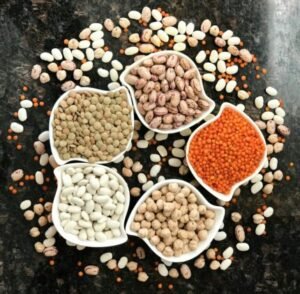
Packed with protein, fiber, and carbohydrates, these plant-based foods provide sustained energy and support muscle recovery, making them essential components of a muscle-building diet.
Here’s why beans and legumes deserve a prominent place in your meal plan:
Rich in Protein:
Beans and legumes are excellent sources of plant-based protein, making them ideal for vegetarians, vegans, and anyone looking to reduce their intake of animal products.
While they may not contain as much protein per serving as animal sources like meat or dairy, they still provide a significant amount, with around 15 grams of protein per cooked cup of beans or lentils.
This protein is essential for muscle repair and growth, helping you recover from workouts and build lean muscle mass.
High in Fiber:
In addition to their protein content, beans and legumes are rich in fiber, which is important for digestive health and overall well-being.
Fiber helps regulate bowel movements, prevents constipation, and promotes a feeling of fullness, which can aid in weight management and portion control.
The fiber in beans and legumes also helps slow down the digestion and absorption of carbohydrates, providing a steady release of energy to fuel your workouts and support muscle recovery.
Complex Carbohydrates:
Beans and legumes are complex carbohydrates, meaning they contain longer chains of sugar molecules that take longer to digest.
This results in a gradual and sustained release of glucose into the bloodstream, providing lasting energy for your muscles and brain.
Consuming beans and legumes before or after workouts can help replenish glycogen stores and support muscle recovery without causing spikes in blood sugar levels.
Nutrient Density:
In addition to protein, fiber, and carbohydrates, beans and legumes are also rich in essential vitamins and minerals that support overall health and muscle function.
They’re particularly high in folate, potassium, magnesium, and iron, all of which play important roles in energy metabolism, muscle contraction, and oxygen transport.
Including a variety of beans and legumes in your diet can help ensure that you’re getting a wide range of nutrients to support your muscle-building efforts.
Incorporating Beans and Legumes into Your Diet:
Bean-based Soups and Stews:
Use beans and legumes as a base for hearty soups and stews, adding vegetables, herbs, and spices for flavor and nutrition.
Bean Salads:
Create colorful and nutritious salads using beans, lentils, or chickpeas as the main ingredient. Mix them with fresh vegetables, herbs, and a simple vinaigrette for a satisfying meal.
Bean Tacos or Burritos:
Swap out meat for beans or lentils in tacos or burritos for a plant-based twist on a classic dish. Top with salsa, avocado, and a dollop of Greek yogurt for added flavor and protein.
Hummus and Bean Dips:
Enjoy beans and legumes in the form of dips like hummus or black bean dip, served with whole grain crackers, vegetables, or as a spread on sandwiches and wraps.
8. Cottage Cheese
Cottage cheese is a versatile dairy option that’s beloved by many fitness enthusiasts for its high protein content, low fat, and slow-digesting properties.
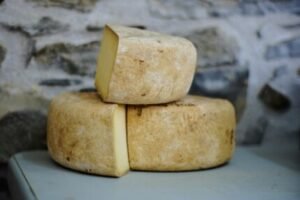
This creamy cheese is not only rich in protein but also provides a source of casein protein, making it an ideal choice for a bedtime snack to support overnight muscle repair.
Here’s why cottage cheese deserves a place in your nighttime routine:
High-Protein Content:
One of the main reasons cottage cheese is valued by those looking to build muscle is its high protein content.
Just one cup of cottage cheese provides around 25 grams of protein, making it an excellent source of this essential nutrient.
Protein is crucial for repairing and rebuilding muscle tissue, especially during periods of rest, such as overnight.
Slow-Digesting Casein Protein:
Cottage cheese is particularly rich in casein protein, a type of protein that is digested slowly by the body.
Unlike whey protein, which is rapidly absorbed, casein protein forms a gel-like substance in the stomach, leading to a slower release of amino acids into the bloodstream.
This slow release provides a steady supply of amino acids to your muscles throughout the night, supporting overnight muscle repair and growth.
Bedtime Muscle Repair:
Consuming cottage cheese as a bedtime snack can help ensure that your muscles have a continuous supply of protein and amino acids while you sleep.
This can be especially beneficial for athletes and individuals engaged in regular strength training, as the overnight hours are when your body undergoes the majority of its muscle repair and growth processes.
Nutrient Profile:
In addition to its protein content, cottage cheese is also a good source of calcium, phosphorus, and other essential nutrients that support overall health and muscle function.
Calcium is important for bone health and m
uscle contraction, while phosphorus is involved in energy metabolism and the synthesis of ATP, the body’s primary energy source.
Versatility in Usage:
Cottage cheese is incredibly versatile and can be enjoyed in various ways as a bedtime snack:
Plain:
Enjoy cottage cheese on its own or with a sprinkle of black pepper for a simple and satisfying snack.
Mix-ins:
Add cottage cheese to smoothies, oatmeal, or yogurt bowls for an extra protein boost.
Toppings:
Top cottage cheese with sliced fruit, nuts, seeds, or a drizzle of honey for added flavor and nutrients.
In Recipes:
Use cottage cheese as a substitute for ricotta in recipes like lasagna, stuffed shells, or pancakes for a protein-packed twist on classic dishes.
9. Tofu and Tempeh
For those following a plant-based diet or simply looking to diversify their protein sources, tofu and tempeh are two versatile options that pack a nutritional punch.

These soy-based foods are not only rich in protein but also provide essential nutrients for muscle health, making them valuable additions to any diet. Here’s why tofu and tempeh deserve a place on your plate:
Complete Protein Sources:
Both tofu and tempeh are complete protein sources, meaning they contain all nine essential amino acids that your body cannot produce on its own.
This makes them excellent options for vegetarians, vegans, and anyone looking to reduce their intake of animal products while still meeting their protein needs.
A 3-ounce serving of tofu provides around 8 grams of protein, while the same serving size of tempeh offers approximately 16 grams of protein.
Versatility in Cooking:
Tofu and tempeh are incredibly versatile and can be used in a variety of dishes, from stir-fries and curries to salads and sandwiches.
They absorb flavors well and can be seasoned and prepared in countless ways to suit your taste preferences.
Tofu has a softer texture and a neutral flavor, making it ideal for absorbing sauces and marinades, while tempeh has a firmer texture and a slightly nutty taste that adds depth to dishes.
Rich in Essential Nutrients:
In addition to their protein content, tofu and tempeh are rich in essential nutrients that support muscle health and overall well-being.
They’re particularly high in iron, calcium, and magnesium, which are important for muscle function, energy production, and bone health.
Tofu is also a good source of phosphorus, manganese, and selenium, while tempeh provides probiotics that support gut health and digestion.
Soy Isoflavones:
Both tofu and tempeh contain soy isoflavones, which are plant compounds that have been studied for their potential health benefits.
These compounds may have anti-inflammatory properties, promote heart health, and even support muscle recovery and growth.
While more research is needed, incorporating tofu and tempeh into your diet may offer additional advantages beyond their protein content.
Incorporating Tofu and Tempeh into Your Diet:
Stir-fries:
Use tofu or tempeh as a protein source in stir-fried dishes with vegetables, noodles, and your favorite sauces.
Salads:
Cube tofu or crumble tempeh onto salads for an extra boost of protein and texture.
Grilling or Baking:
Marinate tofu or tempeh and grill or bake them for a flavorful and protein-rich main dish.
Sandwiches and Wraps:
Add slices of tofu or strips of tempeh to sandwiches, wraps, or burgers for a plant-based protein option.
10. Nuts and Seeds:
Nuts and seeds are not only delicious but also packed with a variety of nutrients that are essential for muscle function, energy production, and overall health.

Whether you’re enjoying them as a snack or adding them to meals, nuts and seeds offer a convenient and nutritious way to support your fitness goals.
Here’s why almonds, walnuts, chia seeds, and other nuts and seeds are a must-have in any muscle-building diet:
Healthy Fats:
Nuts and seeds are rich in healthy fats, including monounsaturated and polyunsaturated fats, which are important for heart health and hormone production.
These fats provide a concentrated source of energy that can fuel your workouts and support muscle recovery.
Including a variety of nuts and seeds in your diet can help ensure that you’re getting a good balance of omega-3 and omega-6 fatty acids, which are essential for optimal health.
Protein:
Nuts and seeds are also excellent sources of plant-based protein, making them a valuable addition to vegetarian, vegan, and omnivorous diets alike.
Almonds, for example, contain around 6 grams of protein per ounce, while chia seeds provide approximately 4 grams of protein per ounce.
Protein is essential for repairing and building muscle tissue, making nuts and seeds an important component of any muscle-building diet.
Micronutrients:
In addition to healthy fats and protein, nuts and seeds are packed with essential micronutrients that support muscle function and overall health.
They’re particularly high in vitamins and minerals such as vitamin E, magnesium, potassium, and zinc.
These nutrients play various roles in energy metabolism, muscle contraction, and immune function, helping you perform at your best both in and out of the gym.
Fiber:
Nuts and seeds are also rich in fiber, which promotes digestive health, regulates blood sugar levels, and helps you feel full and satisfied after meals.
This can be especially beneficial for weight management and portion control, as fiber-rich foods can help prevent overeating and support healthy digestion.
Including nuts and seeds in your diet can help ensure that you’re getting enough fiber to support your overall well-being.
Versatility in Usage:
One of the best things about nuts and seeds is their versatility in usage. Here are some ideas for incorporating them into your diet:
Snacks:
Enjoy a handful of mixed nuts or seeds as a satisfying and nutrient-rich snack between meals.
Salads:
Sprinkle chopped nuts or seeds over salads for added crunch, flavor, and nutrition.
Smoothies:
Add a spoonful of nut butter or a sprinkle of chia seeds to your smoothies for an extra boost of protein and healthy fats.
Oatmeal:
Stir chopped nuts or seeds into your morning oatmeal for added texture and nutrition.
Trail Mix
Make your own trail mix with a combination of nuts, seeds, dried fruit, and dark chocolate for a portable and energizing snack.
Also Read
How Much Protein Do You Really Need to Build Muscle?
Medically reviewed by Dr. Ramesh Gaddam, M.D.

General Physician, Diabetologist, and Critical Care Specialist.
Discover more from Health Build-Up
Subscribe to get the latest posts sent to your email.
